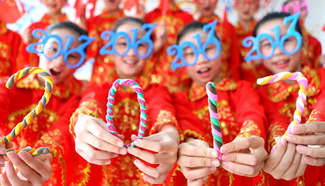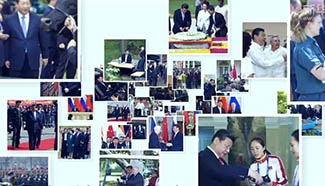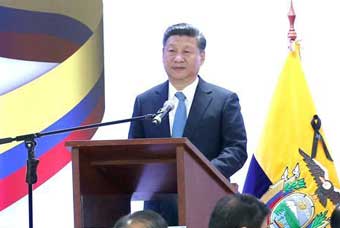By Raimundo Urrechaga
HAVANA, Dec 31 (Xinhua) -- As 2016 winds down, Cubans look back on a year of momentous change with traditional way of celebrations.
The death of former stale leader Fidel Castro, and the visit by U.S. President Barack Obama were the two biggest events in the Caribbean nation.
Nonetheless, celebrations are bringing Cuban families together for a traditional meal and a toast to a prosperous new year.
This is a time when Cubans usually set new goals and hopes for the coming year with midnight marking the beginning of new opportunities.
"We will never lose the enthusiasm to pursue new goals. It's important to have good health, prosperity and good luck in the year ahead, which is what we all aspire to," Mayra Dominguez told Xinhua as she prepared for the festivities.
Another essential element are the rites performed on the night of New Year's Eve, all related to bringing happiness and well-being.
Cuba, characterized by its ethnic, cultural and religious diversity, does not escape long traditions that reflect its mixture of European, African, Anglo-Saxon, Caribbean and Asian influences.
Each region of the country has its peculiarity but music and plentiful food are always the same.
"We're preparing our meal for tonight as all our family will come together to celebrate the arrival of 2017," said Jose Marin, a 49-year-old bus driver.
The main dish is often roasted pork, specially marinated with a sauce of orange or lemon, oil and garlic called "Mojo".
This typical meal is accompanied by "moros y cristianos" rice (rice with black beans), the boiled yucca (cassava), a mixed salad of lettuce, tomato, cabbage and onions, and fried sweet bananas.
The dinner usually ends with seasonal desserts like homemade custard or almond nougat, a Spanish dessert that is popular at this season.
The New Year coincides with the anniversary of the triumph of the Cuban Revolution, giving the date a special connotation.
One of the most widespread traditions is to throw a bucket of water into the street from doors, balconies and terraces as a sign of cleanliness and renovation. The contents of the bucket represents getting rid of bad aspects of the previous year.
Others walk around the neighborhood with a suitcase to attract travel and prosperity.
In rural villages, especially in the center of the island, the "burning of the old year" is performed, personified in a rag doll. This is a purification ritual to ward off bad luck or negative energies of the period that ends, as well as transition to a new beginning.
In recent years other "imported" traditions have become popular such as eating 12 grapes at midnight, one for each month of the New Year and each carrying a different wish.
Regardless of their background, Cubans celebrate the end of the year in a myriad of ways. These celebrations may not all be as colorful as those in other countries, but they carry an authentic familiarity that defines Cubans as a people, with the same desire of prosperity and happiness to which all aspire.










